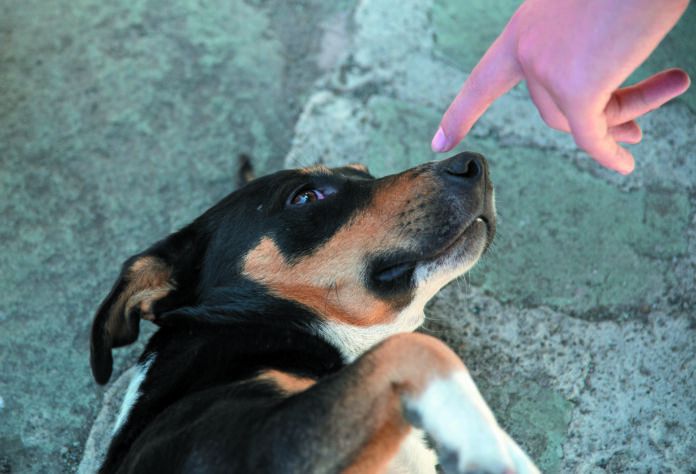Recent television and online programs showing punishment-based training methods for dogs, including the use of painful collars, are causing animal behaviorists and others to speak out. Many experts have also expressed concern about these shows’ promulgation of debunked notions of pack mentality and, by extension, alpha dogs.
There are no dog packs with alpha leaders. Packs are a wolf thing, and while some people believe that dogs vie with their human guardians for the dominant alpha position, they do not. Yes, a dog may try to get access to a desired resource like food, or a certain toy, or an interesting scent on the other side of the road. But dogs are not trying to dominate people by going after these coveted things — they just want what they want. Thus, showing a dog “who’s boss” doesn’t teach him anything. Dogs do respond well, however, to getting rewards for collaborative cooperation — what’s known as positive training.
For some further perspective on the matter, we caught up with Stephanie Borns-Weil, DVM, who heads the Animal Behavior Service at Tufts.
Your Dog: Why does the idea persist that dogs are trying to dominate us and that we have to act as the ‘alpha’ to show who’s boss?
Dr. Borns-Weil: Dominance says a great deal about what motivates us. That’s probably why the idea has so much staying power even though it has nothing to do with dogs. It is also probably born of frustration when our dogs don’t do what we want, combined with a lack of understanding of canine needs and communication abilities.
Your Dog: Why would frustration and a lack of understanding make us want to dominate a dog?
Dr. Borns-Weil: Dominance offers an easy explanation that allows for us to “fix” the problem by just bringing force to bear in order to stop what we do not like. Explaining the animal’s behavior away by saying the dog is trying to be dominant and thus needs to be forcefully stopped in her tracks allows us to sidestep the tough questions, like: Is the unwanted behavior normal for dogs? Is it occurring because the dog’s basic needs are not being met for social connection, exercise, mental stimulation, and opportunities to engage in species- or breed-specific behaviors? Are the expectations of the person realistic for a dog? For this dog? Does the dog understand what you are trying to communicate in training?
Your Dog: That all makes sense, but when you watch dogs being punished on television or videos, it really seems to work to curb or change their undesirable behavior.
Dr. Borns-Weil: Punishment is effective at shutting down unwanted behaviors in the presence of the punisher, but that’s only in the short term. Once the camera stops rolling, the dog hasn’t learned anything other than to avoid more punishment. Painful or fear-inducing punishment has been shown in the long run to be less effective than positive reinforcement-based approaches, which build a better, stronger human-animal bond. Forceful training methods, on the other hand, have been shown to increase the risk of aggression.
Your Dog: Wouldn’t people get that instinctively, though?
Dr. Borns-Weil: I think people do get it instinctively. With few exceptions, those who use these methods on their dogs are good people and simply follow through on what they keep being told is the right thing to do. Perhaps that is why there is such strong resistance to admitting that painful punishment-based devices like electric training collars and choke chains actually do cause pain and fear. Clients erroneously tell me over and over that their electric collars do not really cause pain or discomfort. It is what they are told, but when they really look, they may see signs of distress, anxiety, and disengagement.
I have less sympathy for dog training professionals who promote these methods, whether on a television show or a social media platform, because they are claiming expertise and should know the science better. They should know that dogs’ skin barrier is seven times thinner than ours, that an electric shock goes a much longer way with a dog than a person.
Your Dog: Is there science that shows punishment is not the way to go in general?
Dr. Borns-Weil: It has been shown indisputably that positive training methods, which involve praise, treats, and toys in exchange for cooperation, are what work over the long term — and in the process strengthen rather than destroy a person’s bond with their pet. The problem is that positive training doesn’t necessarily make for compelling television.
Your Dog: What do you mean?
Dr. Borns-Weil: Confrontation is more dramatic than positive training, which progresses slowly and steadily over time. Saro Boghozian, a certified dog trainer and critic of punishment-based training methods, put it well when he said publicly that watching that on television would be akin to “watching paint dry.” I agree.
Who would want to watch someone like me sit with someone for an hour listening to their pain and disappointment and shame about having a ‘bad’ dog or having ‘failed’ because their pet misbehaves? Who wants to listen to slow talk about the ways in which dogs learn and how their environments can be modified to accommodate them so they can cooperate better, and how to use methods that take time and work to implement? Understanding more about empathy and gradual improvement over time makes for deep and meaningful cross-species relationships — but it is not dramatic. It does not have the fast pace television requires.
Your Dog: What about combining punishment training with positive reinforcement, as some shows do?
Dr. Borns-Weil: Combining painful or fear-inducing punishment or negative reinforcement with positive reinforcement is not a step in the right direction. It raises the stakes for the dog but does not make for a more focused or eager learner. Would you be more likely to play a slot machine if it paid out a lot when you got it right but took a huge chunk of your salary if you got it wrong?
I sincerely hope shows that use punishment, whether or not combining it with positive reinforcement, never make it to the screen, or at least are not renewed. The alpha notion, the notion that a genuine, loving, and respectful relationship can be founded on violence and that pain and fear are more effective at training dogs than positive reinforcement is simply wrong.
The whole idea of people being taught to cause their pets pain and fear makes me sad, not only for dogs but also for people. I think that when someone pushes a button that causes their dog to yelp or freeze in pain, fear, and confusion, it not only hurts the dog but also breaks something essential in the person. Each time we hurt someone we care about, someone dependent on us, I think we die a little.
Next month: How to choose a trainer who will help your dog collaborate with you while enriching your bond with your pet.





